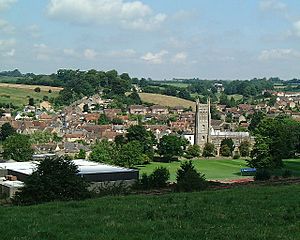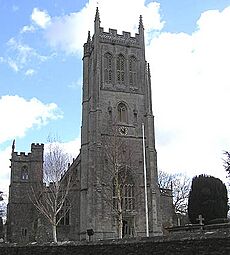Bruton facts for kids
Quick facts for kids Bruton |
|
|---|---|
 Bruton viewed from the Dovecote |
|
| Population | 2,907 (2011) |
| OS grid reference | ST684350 |
| Unitary authority |
|
| Ceremonial county | |
| Region | |
| Country | England |
| Sovereign state | United Kingdom |
| Post town | BRUTON |
| Postcode district | BA10 |
| Dialling code | 01749 |
| Police | Avon and Somerset |
| Fire | Devon and Somerset |
| Ambulance | South Western |
| EU Parliament | South West England |
| UK Parliament |
|
| Website | Town Council |
Bruton (/ˈbruː[unsupported input]/ BROO-tən) is a small market town in Somerset, England. It sits on the River Brue and the A359 road. The town is located about 7 miles (11 km) south-east of Shepton Mallet.
Bruton is home to a museum. It displays items from the Jurassic period and later. The museum even has a table used by the famous author John Steinbeck during his visit. The River Brue can sometimes flood. In 1768, a flood destroyed a stone bridge. To prevent future floods, a protective dam was built upstream in 1984.
Contents
Discovering Bruton's Past
How Old is Bruton?
The Church of St Mary, Bruton was first built in the 7th century. This shows Bruton has a very long history. The town was mentioned in the Domesday Book of 1086. Its name, Briuuetone, means "Vigorously flowing river." This name comes from old English and Celtic words.
What Was Bruton Abbey?
Bruton Abbey was a medieval priory (a type of monastery). It belonged to the Augustinian order of monks. After monasteries were closed down in England, the Abbey was sold. A courtier named Sir Maurice Berkeley (died 1581) bought it. His family turned it into a large mansion. This mansion was later taken down in the late 1700s.
The Bruton Dovecote: A Historic Landmark
The Dovecote is a historic building that overlooks Bruton. It was built in the 16th century. Over time, it was used as a house, possibly a watchtower, and a dovecote. A dovecote is a building where pigeons or doves are kept. This building is now managed by the National Trust. It has over 200 pigeonholes for birds.
Bruton's Place in History and Culture
Bruton was part of a historic area called the hundred of Bruton. The town is even mentioned in an old folk song called "The Bramble Briar".
A rare copy of the Magna Carta was found in Bruton in the 1950s. The King's School claimed ownership of it. Selling this copy helped pay for many new buildings at the school.
Exploring the Bruton Museum
Much of Bruton's history can be found at the Bruton Museum. It is located in the Dovecote Building on the High Street. The museum also has a tourist information office. The Bruton Museum Society was formed in 1989. It works with the community and local schools. They collect local items and stories. The museum moved to its current spot in 1999. It also highlights the time John Steinbeck spent in the town.
In 2014, a famous art gallery called Hauser & Wirth opened near Bruton. It is located at an old farm.
How Bruton is Governed
Local Government in Bruton
Bruton has a parish council, which is called Bruton Town Council. This council helps manage the town. They decide on a local rate (precept) to cover their costs. The town council looks after the town's cemetery and allotments. They also maintain St Mary's churchyard.
The council gives advice on local building plans. They work with the police and other groups on crime, safety, and traffic. They also start projects to fix and improve town facilities. They talk with the district council about roads, drainage, and public transport. Looking after old buildings and the environment are also part of their job.
For bigger local government matters, Bruton is part of Somerset Council. This change happened on April 1, 2023. Before that, it was part of the non-metropolitan district of South Somerset.
Bruton's Parliament Representation
For elections to the UK Parliament, Bruton is part of the Glastonbury and Somerton area.
Getting Around Bruton
Train Services in Bruton
Bruton station is on the Reading–Taunton line. This line is part of the Great Western Main Line. It connects Westbury and Taunton. This route is the most direct way to get from London (Paddington) to the West Country.
The section between Westbury and Castle Cary is also part of the Heart of Wessex line. This line has services between Bristol Temple Meads and Weymouth. In 2015, South West Trains started a direct service from London Waterloo to Bruton.
Bus Services in Bruton
Bus services in Bruton are run by South West Coaches.
Bruton's Unique Geology
Exploring Ancient Rocks at Bruton Railway Cutting
When the railway was built at Bruton Railway Cutting, it revealed ancient rocks. These rocks are from the Middle Jurassic period. This area is one of the best places in England to see different types of fossil ammonites. Ammonites are ancient sea creatures with spiral shells.
Godminster Lane Quarry: A Window to the Past
The nearby Godminster Lane Quarry and Railway Cutting is another important geological site. It is known for its Inferior Oolite limestones. These rocks are also from the Middle Jurassic age. They were formed in a warm, shallow sea about 175 million years ago.
This site is special because its limestones are similar to rocks found in the Cotswolds. However, they contain many ammonites typical of the north Dorset and south Somerset areas. This mix of features makes the site unique for studying ancient geology.
Churches in Bruton
The Church of St Mary was built in the 14th century. The Church of the Holy Trinity in Wyke Champflower dates from 1623. Both are important historic buildings.
John Wesley, a famous religious leader, preached in Bruton in 1776. A Methodist chapel was opened in West End in 1848.
Schools in Bruton
Bruton is known for two old secondary schools: King's School (founded in 1519) and Sexey's School (founded in 1889). Both schools have a sixth form (for older students). They also have a tradition of being boarding schools, where students live at the school.
One important historical figure from Bruton was Hugh Sexey (1556–1619). He was born locally and went to Bruton Grammar School. He became a royal auditor for Queen Elizabeth I and later King James I. After he died, his trustees set up Sexey's Hospital in Bruton to care for the elderly. Sexey's trust was also very involved in supporting education.
Henry Hobhouse (1854–1937) was a politician who helped found Sexey's School. He also helped start Sunny Hill school, which later became Bruton School for Girls. This school was open from 1901 to 2022.
Famous People from Bruton
Many notable people have lived in Bruton, including:
- Koos Bekker (born 1952), a businessman
- Caroline Corr (born 1973), a musician
- Stella McCartney (born 1971), a fashion designer
- Cameron Mackintosh (born 1946), a musical theatre producer
- George Osborne (born 1971), a former politician and newspaper editor
- Iwan Wirth (born 1970), an art dealer
- Joe Wright, a director, and Haley Bennett, an actress
- Sarah Beeny (born 1972), a property developer and TV personality
- Mariella Frostrup, a newspaper columnist
- Aaron Taylor-Johnson (born 1990), an actor, and Sam Taylor-Johnson (born 1967), an artist and director
Images for kids
See also
 In Spanish: Bruton para niños
In Spanish: Bruton para niños




